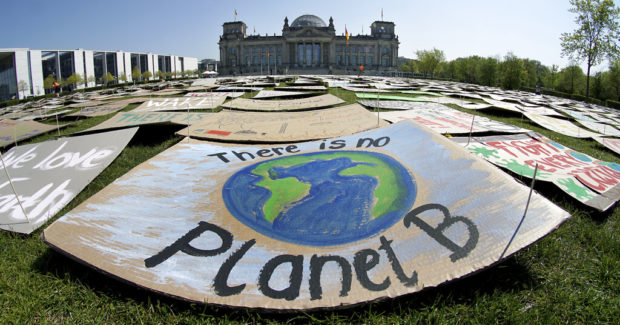
In this Friday, April 24, 2020 file photo, activists place thousands of protest placards in front of the Reichstag building, home of the german federal parliament, Bundestag, during a protest rally of the ‘Fridays for Future’ movement in Berlin, Germany. U.N. Secretary-General Antonio Guterres said Tuesday at a two-day international meeting on climate change, that the coronavirus pandemic has exposed how fragile societies are, but that if governments work together on common challenges, including global warming, it can be an opportunity to ‘rebuild our world for the better.’ (AP File Photo/Michael Sohn)
PARIS — Wealthy countries are falling short on a decade-old promise to ramp up climate finance for the developing world, according to a semi-official report released Friday.
Even those numbers may be inflated, watchdog groups warned.
The 2009 UN climate summit in Copenhagen mandated that poorer nations — historically blameless for global warming, but most at risk — were to receive $100 billion (85 billion euros) annually starting from 2020 to help curb their carbon footprint and cope with future climate impacts.
But where the money was to come from and how it would be allocated were not spelled out, which has made tracking progress toward that goal both difficult and disputed.
As of 2018, the last year for which data is available, money from all sources earmarked for climate-related projects totaled $78.9 billion, up about 11 percent from the year before, the Organisation for Economic Co-operation and Development (OECD) said in a detailed report, its third since 2015.
Public climate finance from developed countries — almost evenly split between bilateral and multilateral sources — accounted for the lion’s share, some $62.2 billion, with another $2 billion in government-backed export credits.
The rest, some $14.6 billion, came from private investment.
How these figures align with the UN-back pledge, renewed in the 2015 Paris Agreement, is subject to interpretation, and the OECD makes a point of not drawing conclusions one way or the other.
‘Mounting threat’
If climate finance in 2019 and 2020 ramped up at the same pace as from 2017 to 2018, the $100 billion-target would be within grasp this year.
But the rate at which money was mobilized had already slowed sharply going into 2018, and the impact of the coronavirus pandemic is still unknown.
“Climate finance is a lifeline for communities facing record heatwaves, terrifying storms and devastating floods,” said Tracy Carty, co-author of an in-depth “shadow report” on climate finance compiled by experts at global NGO Oxfam.
“Even as governments struggle with Covid-19, they must not lose sight of the mounting threat of the climate crisis.”
According to Oxfam, donors reported only $120 billion dollars in climate finance across 2017 and 2018, some $30 billion shy of the OECD estimate for those two years combined.
Less contested but even more controversial is the form that aid has taken, and the countries to which has been allocated.
According to the OECD, nearly three-quarters of public finance given in 2018 was in the form of loans, few of them “concessional”, or at below-market interest rates.
Only a fifth were the out-right grants that developing countries have consistently demanded.
For Oxfam, once loan repayments and interest is stripped out of the calculation, only about $20 billion of “true support” remained in 2018.
‘An overlooked scandal’
“The excessive use of loans in the name of climate assistance is an overlooked scandal,” said Carty, arguing that the world’s poorest countries “should not be forced to take out loans to respond to a climate crisis not of their making.”
The worst offender in this category according to Oxfam was France, which provided almost 97 percent of its bilateral climate aid as loans and other non-grant instruments.
By contrast, the vast majority of aid from Sweden, Denmark, and Britain were in the form of grants.
However much climate assistance was doled out in 2018, very little of it went to the countries most in need, the OECD and Oxfam reports agree.
Some 14 percent went to nations in the Least Developed Countries category, and two percent to developing small island nations, whose very existence is threatened by rising seas, according to the OECD.
Nearly 70 percent went to middle-income countries.
The OECD report does not cover domestic public climate finance or so-called “South-South” assistance between developing countries.
Another long-standing complaint from poorer nations is how funds are split between helping countries cut emissions (mitigation) and cope with climate impacts already in the pipeline (adaptation).
OECD reports that 70 percent of 2018 finance went to mitigation, with only 21 percent allocated for adaptation. Oxfam’s breakdown was roughly the same.
Last month, more than 500 civil society groups called on G20 finance ministers to cancel debts in poorer countries in the wake of the COVID-19 pandemic. Debt repayments were suspended for six months.